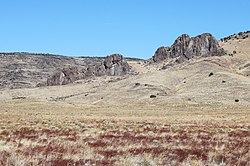San Luis Hills
| San Luis Hills | |
|---|---|
 Sierro del Ojito in the Fairy Hills section of the San Luis Hills | |
| Highest point | |
| Elevation | 2,806 m (9,206 ft)[1] |
| Coordinates | 37°10′0″N 105°44′32″W / 37.16667°N 105.74222°W[2] |
| Dimensions | |
| Area | 428 sq mi (1,110 km2)[3] |
| Geography | |
| Location | San Luis Valley |
| Country | United States |
| State | Colorado |
The San Luis Hills[2] are a group of small mountain ranges in Conejos and Costilla counties in the San Luis Valley in southern Colorado.[4] The individual mountain ranges that make up the San Luis Hills include the Fairy Hills, the Brownie Hills, the Piñon Hills, and the South Piñon Hills. The San Luis Hills' highest point is Flat Top, elevation 9,206 feet (2,806 meters).[1]
Geographical setting
Each of the separate mountain ranges includes flat-topped mesas and hills, and the ranges trend from the southwest to the northeast.[4] Because the individual hills rise from the floor of the San Luis Valley, which is about 7,500 feet (2,300 meters) in elevation,[5] they appear more as hills than mountains, despite rising to eight or nine thousand feet above sea level.
The Hills are all within the Sangre de Cristo National Heritage Area.[6]
Individual ranges
Fairy Hills
The Fairy Hills lie at 37°12′37″N 105°45′14″W / 37.21028°N 105.75389°W.[7] They are north of Colorado State Highway 142 and west of the Rio Grande in Conejos County.
Brownie Hills
The Brownie Hills lie at 37°12′39″N 105°42′50″W / 37.21083°N 105.71389°W.[8] They are north of Colorado State Highway 142 and east of the Rio Grande, in Costilla County.
Piñon Hills
The Piñon Hills lie at 37°07′50″N 105°49′02″W / 37.13056°N 105.81722°W.[9] They are south of Colorado State Highway 142 and west of the Rio Grande, in Conejos County.
South Piñon Hills
The South Piñon Hills lie at 37°04′17″N 105°48′31″W / 37.07139°N 105.80861°W.[10] As their name indicates, they are south of the Piñon Hills in Conejos County, and just north of the New Mexico border.
Geology

The hills are the exposed parts of an intra-rift horst. They are capped by Miocene basalts of the Hinsdale Formation.[11] The basalt is underlain by Oligocene andesite and dacite volcanic deposits of the lower Conejos Formation.[4]
Recreation
The public lands in the San Luis Hills are not developed for recreation. However, some informal hiking trails exist, and mountain climbing and bouldering are possible, especially around the Manassa Dike on south side of Flat Top.[12]
Protected areas
The San Luis Hills Wilderness Study Area occupies a 10,883-acre (4,404-hectare) tract of land in the Piñon Hills. The wilderness study area was established in 1980 and is owned by the Bureau of Land Management.[13]
In 2016, the Western Rivers Conservancy got funding from the Conservation Alliance to purchase a 17,019-acre (6,887-hectare) tract in the Brownie Hills on both sides of the Rio Grande, some of it adjacent to or overlapping with the Rio Grande Natural Area. The plan is to transfer the land to Costilla County, which will manage it for wildlife habitat, agriculture, and public open space.[14]
References
- ^ a b "Flat Top". Geographic Names Information System. United States Geological Survey, United States Department of the Interior. 13 October 1978. Retrieved 31 December 2020.
- ^ a b "San Luis Hills". Geographic Names Information System. United States Geological Survey, United States Department of the Interior. 13 October 1978. Retrieved 31 December 2020.
- ^ Burroughs, Richard L. (1971). "Geology of the San Luis Hills, south-central Colorado". In James, H.L. (ed.). San Luis Basin (Colorado): New Mexico Geological Society 22nd Annual Fall Field Conference Guidebook. New Mexico Geological Society. pp. 277–287.
- ^ a b c Thompson, Ren A.; Shroba, Ralph A.; Machette, Michael N.; Fridrich, Christopher J.; Brandt, Theodore R.; Cosca, Michael A. (2015). Geologic map of the Alamosa 30′ × 60′ quadrangle, South-Central Colorado (PDF) (Map). Scientific investigations map ; 3342. Reston, VA: U.S. Department of the Interior, U.S. Geological Survey. p. 2. Retrieved 2020-12-31.
- ^ "San Luis Valley". Geographic Names Information System. United States Geological Survey, United States Department of the Interior. 2001-08-03. Retrieved 2021-01-01.
- ^ "Geology". Sangre de Cristo National Heritage Area. Retrieved 2020-12-31.
- ^ "Fairy Hills". Geographic Names Information System. United States Geological Survey, United States Department of the Interior. 13 October 1978. Retrieved 31 December 2020.
- ^ "Brownie Hills". Geographic Names Information System. United States Geological Survey, United States Department of the Interior. 13 October 1978. Retrieved 31 December 2020.
- ^ "Piñon Hills". Geographic Names Information System. United States Geological Survey, United States Department of the Interior. 13 October 1978. Retrieved 31 December 2020.
- ^ "South Piñon Hills". Geographic Names Information System. United States Geological Survey, United States Department of the Interior. 13 October 1978. Retrieved 31 December 2020.
- ^ "Assessment of the mineral potential of public lands located within proposed solar energy zones in Colorado" (PDF). U.S. Department of the Interior, Bureau of Land Management. July 2012. Retrieved 2020-12-31.
- ^ Elison, Jeff (2020). "chapter 18: Rock climbing in the San Luis Valley: Penitente and beyond". In Beeton, Jared Maxwell; Saenz, Charles Nicholas; Waddell, Benjamin James (eds.). The geology, ecology, and human history of the San Luis Valley. Louisville, Colorado: University Press of Colorado. pp. 466–475. doi:10.5876/9781646420407.c018. ISBN 9781646420414.
- ^ "San Luis Hills Wilderness Study Area". U.S. Department of the Interior, Bureau of Land Management. Retrieved 2020-12-31.
- ^ "Where do you GOCO- April 2018 projects". Great Outdoors Colorado. 2018-05-16. Retrieved 2020-12-31.
External links
 Media related to San Luis Hills at Wikimedia Commons
Media related to San Luis Hills at Wikimedia Commons